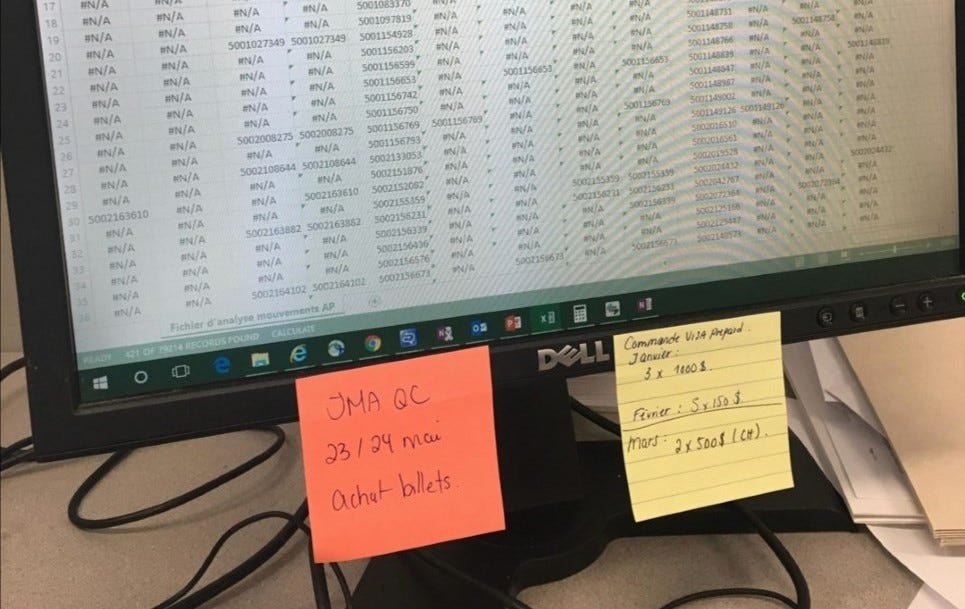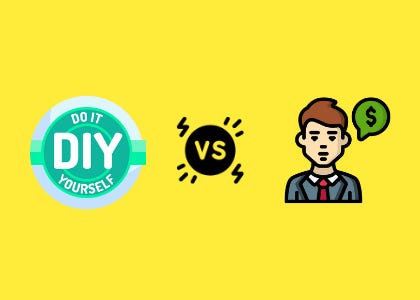DIY Investing vs. Financial Advisor
Which one makes more sense: be a self-directed investor or pay someone to handle it?
Since I experienced both options, I decided to compare them and ultimately, show you which choice would best fit your financial situation.
A bit about my background
March 2018: I start making okay money from a marketing internship and I have zero knowledge in personal finances. All I know is that I have $500 in my bank account, $3000 of student debt, and a Mazda Protégé 2002 given by my brother.
Using VLOOKUP in Excel at 18 bucks an hour, living the dream!
I decide to reach out to a university acquaintance that recently made recruit of the year at Investor Group (IG). I ask him if I can be his client because he seems great and I’m broke AF. Fast forward 4 years later and now I’m managing my own investments myself—I became a self-directed (or DIY) investor.
I don’t have years of experience in the stock market, but I’m super serious about my investments and my money. During those four years with IG, I tried multiple online brokers, lived frugally, joined a fintech startup, and got a mortgage during the crazy housing market we’re living in.
I’m not trying to brag or anything, far from it. I’m not a financial expert and this is not financial advice. I’m just passionate about personal finances and if I can make you learn one thing per month about that or investing, that’s a win in my book. Keep in mind that if I’m able to do it myself, you can do it as well.
Financial advisor; paying someone to make your money grow
My financial advisor (let’s call him Gary) helped me a lot at the beginning. My first assignment was to increase the $500 I had to $5000. Gary explained that this 5k was going to be my “new zero”. I achieved that goal quickly since my expenses were low as a new graduate.
This exercise showed me that my chequing account was fluctuating and that the 5k was moving between $2500 and $7500. In retrospect, I think 5k was a bit much and 2k would have easily done the job. Also, keeping that amount in my chequing account was making me lose money because of bank fees. I should have transferred it into a TFSA account.
Gary showed me the ropes and I’m thankful for that. We put money into a TFSA with automatic bank transfers and since I was pretty risk-averse, I made a 5.44 % return in 4 years, which isn’t bad since I needed that money for the short term.
However, Gary and I parted ways because when I looked at my investments, I realized that I could be the one handling them. I still appreciate everything he did for me because without him, I would not be financially literate today.
Let’s see the pros and cons of working with a financial advisor:
Pros
Show you the ropes of personal finances.
Understand your risk profile and help you set goals.
Save you time having to learn everything by yourself.
Cons
Sometime requires a minimum amount of holding.
Won’t necessary suggest financial products that benefit you.
Huge upfront cost or commission fee that compound with time.
DIY investing; taking control of your investments yourself
If thinking about finances and investments gives you nausea, there’s a high chance that this option is not for you. However, if you’re interested in the stock market, want to have more control over your money, and save on fees, it can be worth it to become a self-directed investor.
Keep in mind that it requires time to research everything, but with this newsletter, I’ll do my best to reduce it. I built a system where I’m taking 2-3 hours every month to manage my investments. The cost difference is huge compared to when I was working with Gary.
My investment strategy is rather simple: I defined financial goals I want to reach over the next 5 years and how much money I’m planning to invest for the long term. 60% of my portfolio is for the long term while I’m keeping 20% for short term goals and another 20% on a medium term horizon.
There’s multiple types of self-directed investors, but I believe that the best investment strategy for me (and for you hopefully) is having a couch potato portfolio. This type of portfolio doesn’t need a lot of monitoring and rebalancing, but offers significant return on the long run.
If this type of investing interests you, you’re at the right place! I might write about day trading and penny stocks, but I don’t recommend those types of investing because it’s similar to gambling and I don’t want to gamble my life savings.
Let’s dive in the pros and cons of being a self-directed investor:
Pros
Low management expense ratios (MERs).
You can build a custom portfolio for your needs.
Lots of easy platforms to get started.
Cons
Small mistakes can cost you lots of money.
Portfolio management can be tedious.
Lots of research and strategies are necessary.
Why not both?
Ok but Gab, can I work with a financial advisor and be a DIY investor at the same time?
Oh sure you can, but it can be tricky. I’m currently doing both with a financial advisor where I’m investing only $100 a month. I’m saying only because that’s 9% of what I’m investing monthly.
However, the majority of financial advisors want wealthy clients. So it’s a bit of a chicken and egg problem. Financial advisors working with less wealthy customers might be starting out so your investments might not perform as well as you think.
How to get started?
As the first subscribers to my newsletter, you will right below find a Google Sheet template to start investing by yourself.
Thank you for reading, I truly hope you learned something today!
P.S. If you have suggestions of the type of content you would like to be included in the next newsletter, let me know. I have a few ideas like a review of my own portfolio, stock market news, financial software reviews and more.
Note that I am not an investment professional, and this is not investment advice.





